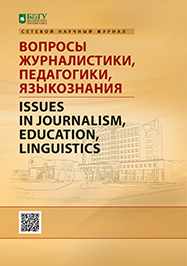Application principles of folklore tradition folk instruments in folk singing performance (“Folklore tradition folk instruments” teaching discipline inquiries)
DOI:
https://doi.org/10.18413/2712-7451-2020-39-2-246-254Keywords:
folk education, syncretism, folklore, regionality, song genre, musical accompanimentAbstract
The appeal of future leaders of folk singing groups to various instruments of folk tradition is
due to the increased interest of musicians in folk peasant-Posad musical and instrumental culture, as well
as the task of preserving the style of song and instrumental language, which helps to create an ethnic
artistic image of folk works. The specifics of the use of traditional folk instruments in folk-singing
performance has its own characteristics, due to the syncretic nature of folk art. The authors present a
proven system of using folk instruments of the folk tradition in folk singing performance, based on the fundamental principles: preserving the traditions of folk performance (regionality, genre correspondence,
solo or ensemble character of accompaniment); the convenience of vocal and choral performance, taking
into account the composition, timbres, tessitura capabilities of performers and the expediency of
instrumental and melodic movement; taking into account the regularities of musical accompaniment of
works that determine whether the means of expression of instruments correspond to the nature, content,
stylistic and genre features of the musical material. The principles of application of folk instruments of
folklore tradition in folk-singing performance identified and systematized as a result of the research can
serve as a theoretical and methodological basis for organizing the educational process in educational
institutions of culture and art in the discipline "Folk instruments of folklore tradition".
References
Багрий Ю.А. 1983. Русские трещотки. В кн.: Памяти К. Квитки. М., Советский композитор: 149–165.
Бычков В.В. 2000. Музыкальные инструменты. Основы художественного ремесла. М., АСТ-Пресс, 176 с.
Вертков К.А. 1972. Типы русских гуслей. В кн.: Славянский музыкальный фольклор. М., Наука.
Каминская Е.А. 2015. Игра на ложках. Санкт-Петербург, Лань, 64 с.
Щуров В.М. 1986. Усердские пищики. В кн.: Музыкальная фольклористика. Вып. 3. Ред.-сост. А.А. Банин. М., Сов. Композитор: 269–282.
Банин А.А. 1997. Русская инструментальная музыка фольклорной традиции. М., Государственный республиканский центр русского фольклора, 248 c.
Бойко Ю.Е. 2015. Куда идти народным инструментам? Труды Санкт-Петербургского государственного института культуры, 207: 45–69.
Браславский Д. 1983. Аранжировка сопровождения вокала для инструментальных ансамблей. М., Советская Россия, 90 с.
Буданков О.А., Вахутинский М.Б., Петров В.К. 1991. Практический курс игры на русских народных духовых и ударных инструментах. М., Музыка, 150 с.
Бычков В.В. 2015. Академизация русских народных инструментов: синтез или самостоятельность, единство или размежевание, друзья или соперники? Труды Санкт-Петербургского государственного института культуры, 207: 90–109.
Варламов Д.И. 2015. Теория и практика народного инструментализма: от понятий к действиям. Труды Санкт-Петербургского государственного института культуры, 207: 9–23.
Десятов С.Е. 2002. Возрождение традиционной культуры в сценических формах (из опыта работы с песенно-инструментальным коллективом). В кн.: Ученые записки АГИИК. Ред. кол. О.Н. Труевцева. Барнаул, АГИИК: 210–211.
Имханицкий М.И. 2002. История исполнительства на русских народных инструментах. М., Изд-во РАМ им. Гнесиных, 351 с.
Кирюшина Т. В. 1989. Традиционная русская инструментальная культура. М., ГМПИ им Гнесиных, 52 с.
Мирек А. 1994. Гармоника: прошлое и настоящее. М., Изд-во ИнтерПракс, 756 с.
Рытов Д.А 2001. Традиции народной культуры в музыкальном воспитании детей: русские народные инструменты. М., Гуманит. изд. центр ВЛАДОС, 384 с.
Фаминцын А.С. 1995. Скоморохи на Руси. Санкт-Петербург, Алетейя, 540 с.
Щербакова О.С., Клоков С.Н. 2018. Формирование профессиональных компетенций руководителей народно-певческих коллективов в процессе изучения дисциплины «Народные инструменты фольклорной традиции». Мирнауки, культуры, образования, 5 (72): 235–237.
Bendix R. 1997. In search of authenticity: The formation of Folklore Studies. Gulfport, Madison University of Wisconsin Press, 306p.
Montenyohl E. 1996. Divergent paths: on the evolution of "folklore" and "folkloristics". Journal of Folklore Research. Bloomington: Indiana University Press, 33(3): 232–235.
Abstract views: 514
Share
Published
How to Cite
Issue
Section
Copyright (c) 2020 Issues in Journalism, Education, Linguistics

This work is licensed under a Creative Commons Attribution 4.0 International License.


